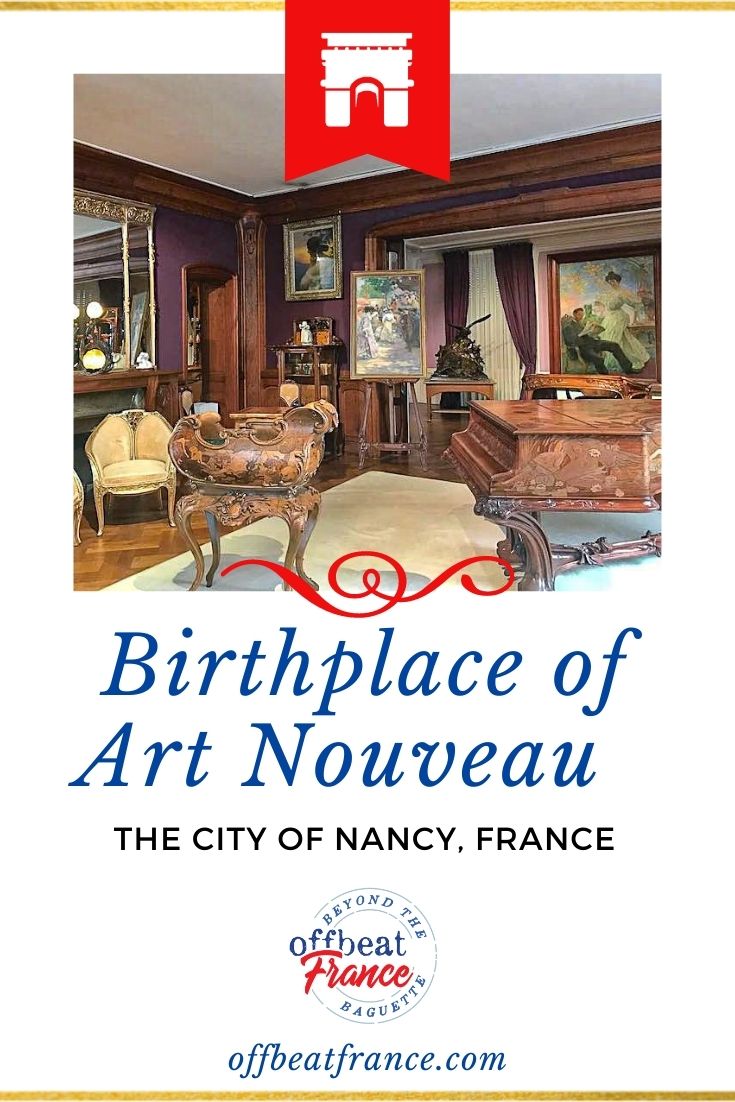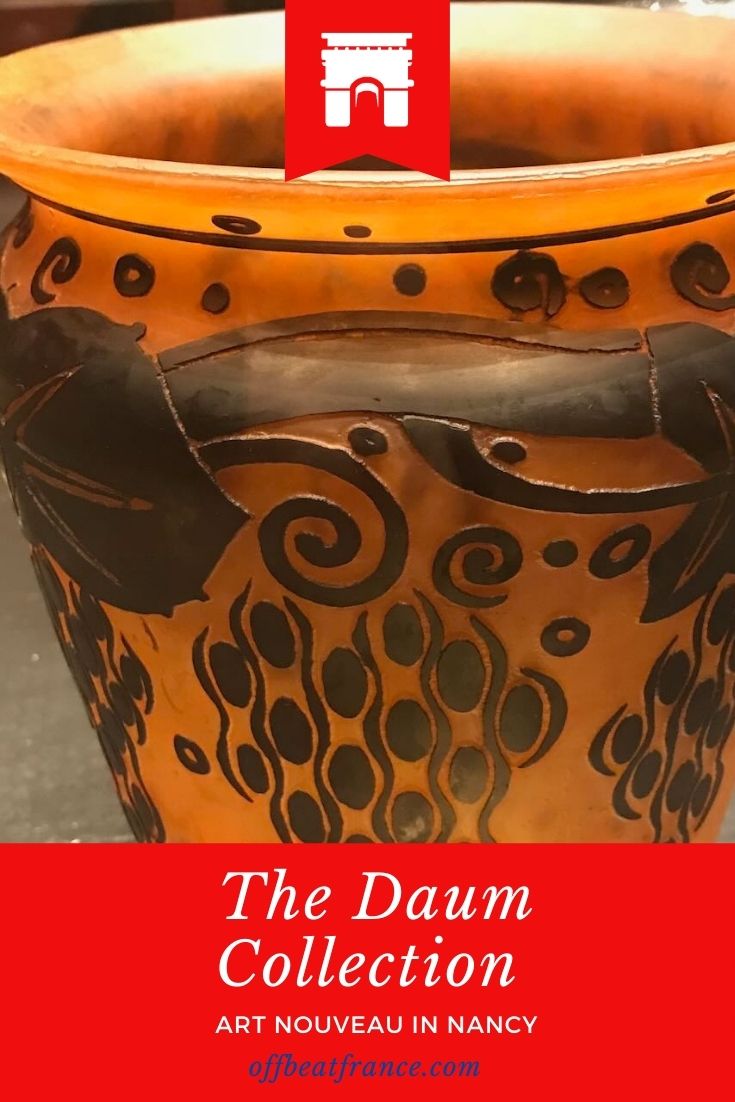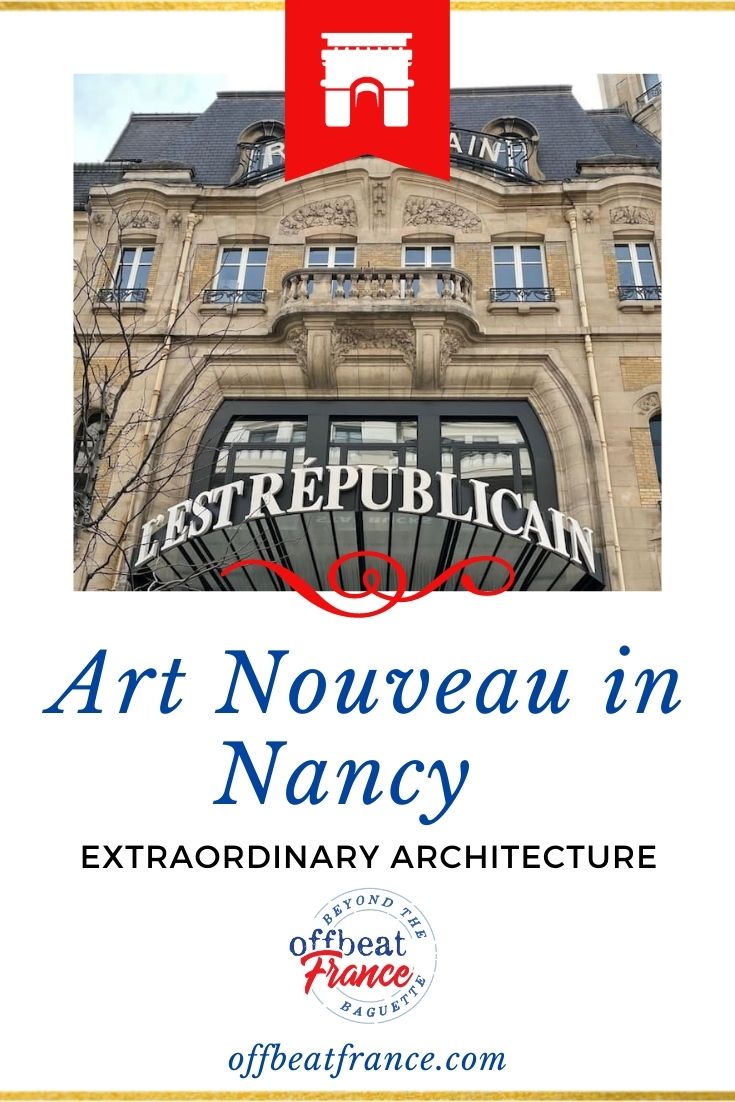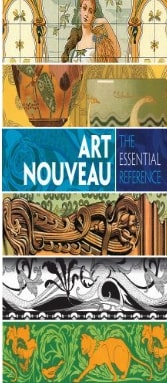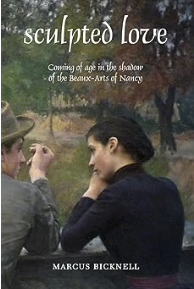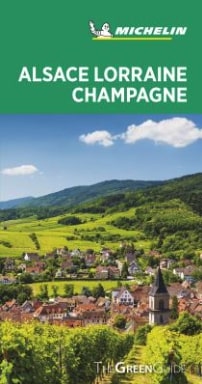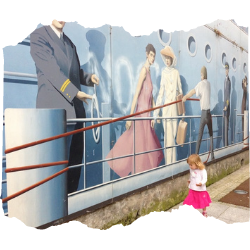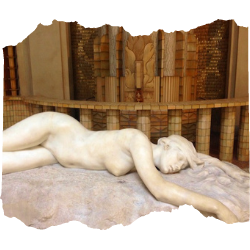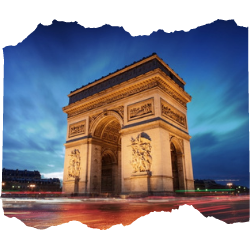Unsure about your French table manners? Click Here to download > > How to avoid these 10 food etiquette mistakes !
- Home ›
- Destinations ›
- Undiscovered France ›
- Nancy
5 unmissable highlights of the ecole de nancy art nouveau
Updated 3 February 2025 by Leyla Alyanak — Parisian by birth, Lyonnaise by adoption, historian by passion
As a fan of Art Nouveau, I was absolutely blown away by Nancy, in eastern France, home of the Ecole de Nancy style. An easy day trip from Paris, you'll discover an artistic heritage so rich the city still breathes Art Nouveau today.
Throughout Europe, as the 19th century gave way to the 20th, Art Nouveau swept all convention away. In France, this art stream was called the Ecole de Nancy, or Nancy School, and was most famous in the city which bears its name.
NOTE: Pages on this site may contain affiliate links, which support this site. See full Privacy Policy here.
Art Nouveau had an incredibly short history – from the 1890s to just before World War I – but the École de Nancy was so rich and vibrant that on some of Nancy's streets, it might as well still be alive.
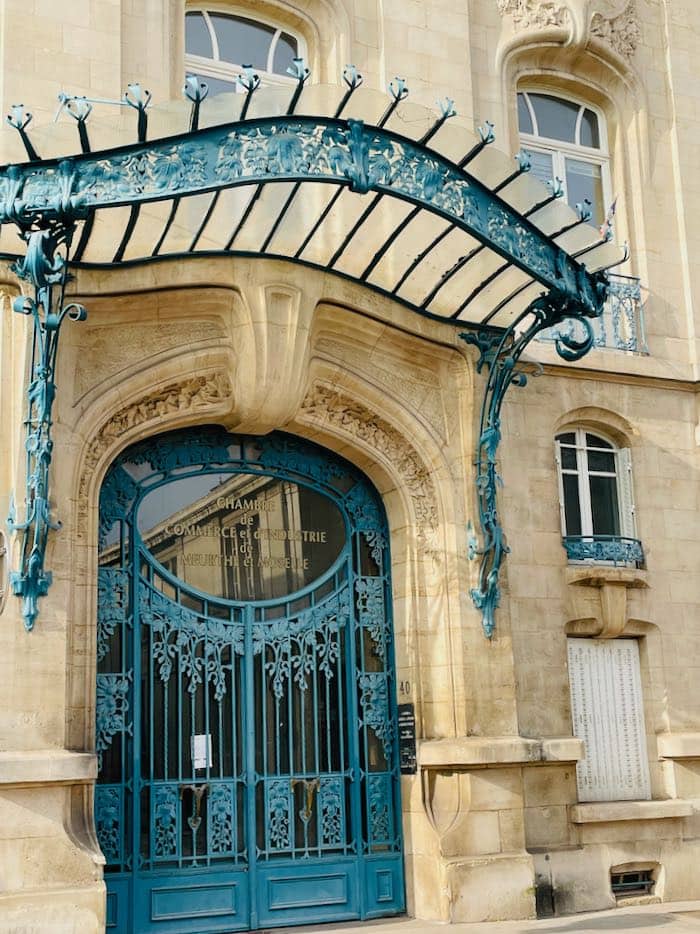
Today, Art Nouveau is back in fashion: walking tours of Art Nouveau neighborhoods are packed, stories set in the Belle Epoque which birthed it are hugely popular, and in bric-a-brac shops and flea markets, Art Nouveau pieces are among the most expensive and coveted, given their rarity.
But the one place in France to see it all at close quarters is right here, in Nancy, just an hour-and-a-half from Paris.
Yet despite this proximity, Nancy isn't yet on everyone's radar.
What makes Art Nouveau unique?
The words "Art Nouveau" mean New Art, and that's exactly what it is.
The full brunt of the industrial revolution had primed the world for something lighter, more natural, so when Art Nouveau appeared, with its sinuous leaves and branches, it was bound to be a success.
It stood out in a number of ways: shapes from nature, of course, but also such elements as asymmetry, attention to detail and a nature-based colour palette.
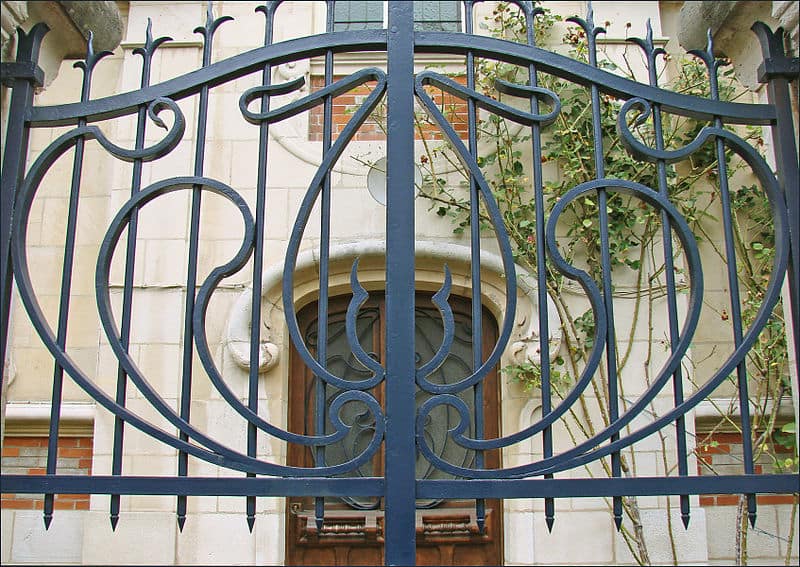 This classic Art Nouveau gate in Nancy shows how the "natural" curves of this style and how art was used for everyday objects. Photo Jean-Pierre Dalbéra via CC BY 2.0
This classic Art Nouveau gate in Nancy shows how the "natural" curves of this style and how art was used for everyday objects. Photo Jean-Pierre Dalbéra via CC BY 2.0Art Nouveau sought both form and function, striving to make the useful beautiful.
It blurred the boundaries between fine arts and applied arts, and turned everyday objects − lamps and balustrades and metal grills − into art. That art would be found not only in paintings but also in architecture, glassware, furniture design and graphic art.
Art Nouveau in France first appeared in Paris, making an entrance like a Grande Dame at the 1889 Universal Exhibition in Paris, just like the Eiffel Tower.
The exhibition introduced a new style of furniture, filled with gracious curves, designed by a certain Emile Gallé, who would go on to create the Ecole de Nancy.
Art Nouveau was incredibly short-lived, barely a generation, yet it left behind a heritage so distinctive that more than 100 years later, we still gaze in wonder. Art Nouveau: The Essential Reference is not only a reference book, but a hoard of stunning visual reminders of just how gorgeous this style was.
Buy from Better World Books
The École de Nancy
Propelled by the Industrial Revolution, Nancy's vocation as a center of art could not have been predicted.
Nor could anyone guess that the Franco-Prussian War, which France lost in 1871, would have such tremendous consequences for the city's artistic future.
After the war, Germany annexed part of Lorraine, including Alsace, reshaping Nancy's future. Suddenly, the city found itself near the German border, and became eastern France's largest city. Strasbourg, for example, was now German.
And Nancy thrived.
Humming with industry, it attracted people from the countryside looking for work. It also attracted French industrialists caught on the wrong side of the border by the war, but with no desire to become German.
OPTING TO STAY FRENCH
They were known as the "optants", the men and women who decided they wanted to stay French when France ceded Prussia a large region with 1.6 million inhabitants (and 20% of its mining industry). The population was to be German, but a clause in the Treaty of Frankfurt allowed those who wanted to remain French to go back across the border. No one really knows how many chose this option – estimates range from 50,000-280,000.
Many of these were artists. Most who decided to leave were from the better-off classes, the liberal professions, usually urban, as well as young men wishing to avoid compulsory military service in Prussia.
And – there were many artists who would influence Nancy's cultural development and contribute to the city's emergence as a hub for the Art Nouveau movement.
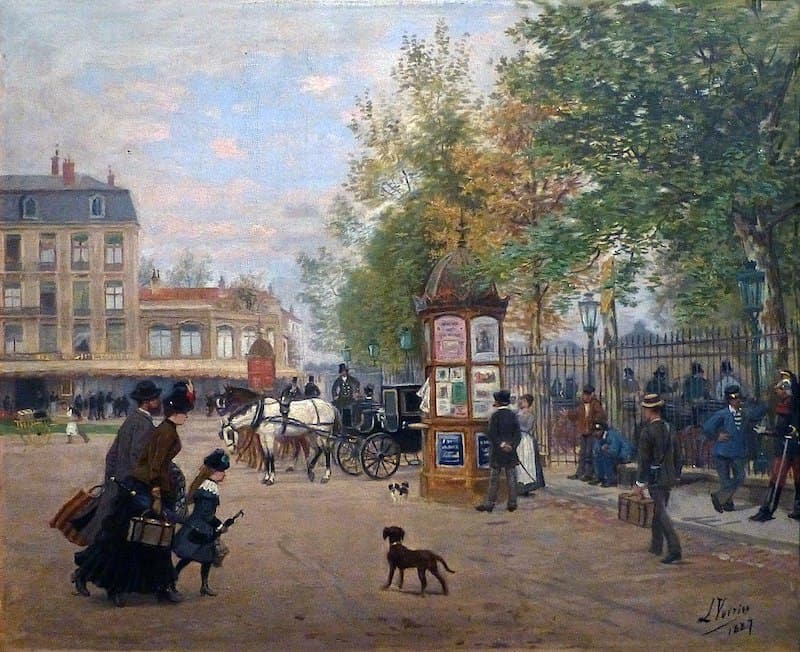 Place Thiers in Nancy in 1887. Painting by Léon Voirin, photographed by Ji-Elle CC BY-SA 3.0, now in the Musée Lorrain
Place Thiers in Nancy in 1887. Painting by Léon Voirin, photographed by Ji-Elle CC BY-SA 3.0, now in the Musée LorrainIn just a few years, Nancy's population had doubled with the influx of new residents.
A combination of incoming population and the general evolution of art across Europe set the scene for the city's artistic currents.
By 1901, Nancy’s artists, from cabinet makers to glass designers, united to form the École de Nancy – France’s heart of Art Nouveau.
This turned Nancy into a flagship venue for this style.
If you're curious about this period of French history, the Franco-Prussian War and the advent of Art Nouveau and the Ecole de Nancy, Sculpted Love will take you through the high points of that time and make you experience it through the eyes of two young women experiencing the changes of their era. Buy from Amazon
The Ecole de Nancy, more formally known as the Provincial Alliance of Art Industries, has been compared to the Arts and Crafts movement in England, given their similar designs.
But there was a major difference: the Arts and Crafts was purely artistic and artisanal, whereas the École de Nancy married art and industry.
Together, artists and industrialists worked for the common good − they wanted to make art more democratic and accessible, and expose the enormous talent available locally.
They succeeded, and their work created a stir.
Today throughout Nancy, you can still see the results of that artistic explosion in the many houses, furniture pieces, stained glass and other forms of art that emerged from this movement.
The Green Guides, which originated in France, are particularly good for culture in France. This edition covers the city of Nancy, of course, but the entire region as well, with all its history and sights. It stretches to cover all of Lorraine, but also the Alsace and Champagne regions, all pulled together with flawless research.
Order from Better World Books
Where to see Art Nouveau in Nancy?
The question is almost, "Where NOT to see it?"
It's all over town, in the streets, at the top of buildings, inside museums.
These five sights must be on your itinerary!
1. Villa Majorelle
When woodworking genius Louis Majorelle decided to move his workshops, he also decided he'd like to live on site. The Villa Majorelle was the result (he called it Villa Jika, which, pronounced in French, are the initials of his wife, Jane Kretz).
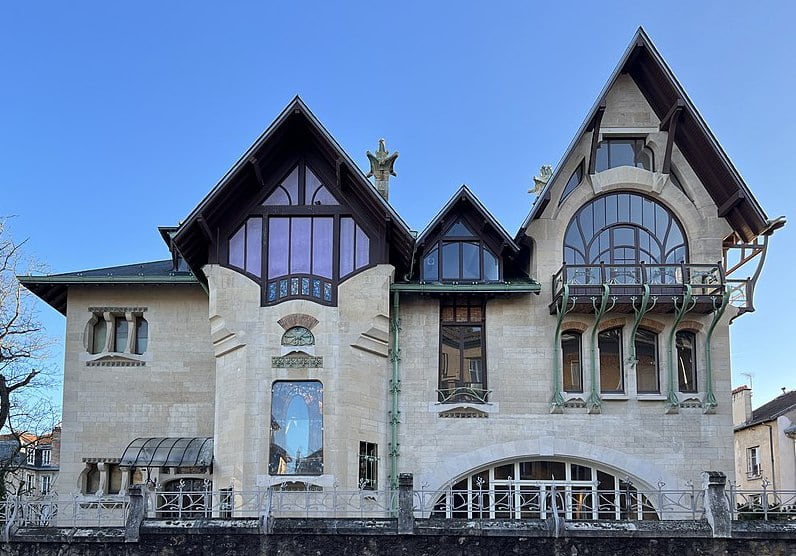 Exterior of the Villa Majorelle, photo Chabe01, CC BY-SA 4.0
Exterior of the Villa Majorelle, photo Chabe01, CC BY-SA 4.0Majorelle wanted his home to be an experimental haven, and he invited the best designers of the time to let their imaginations run wild. His little gem of a house is the result.
His studio was on the top floor, facing a huge half-moon window through which the light streamed in.
When you visit, look into every corner of the house, because only after leaving did I realize how much I'd missed...
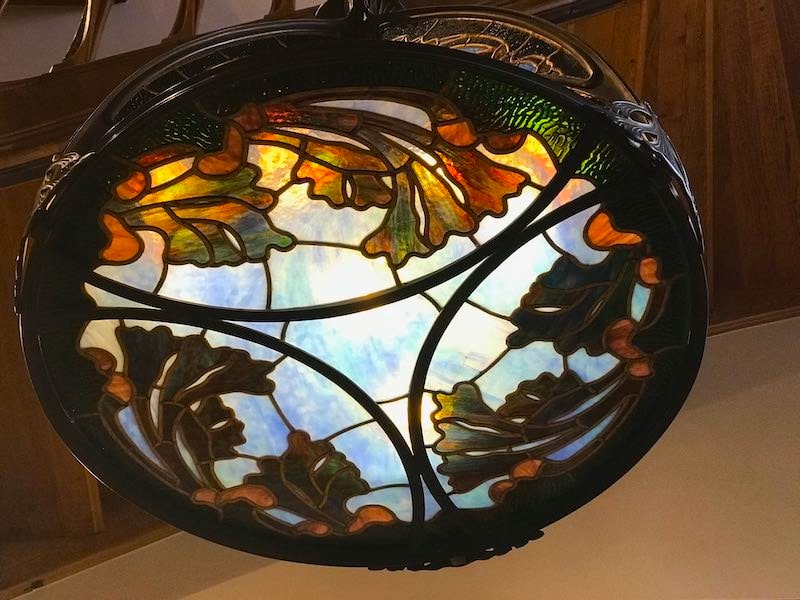
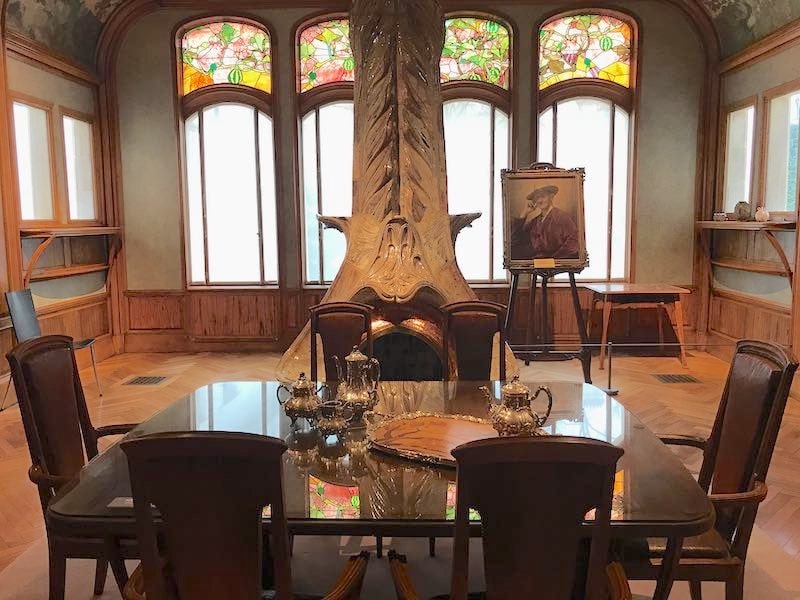
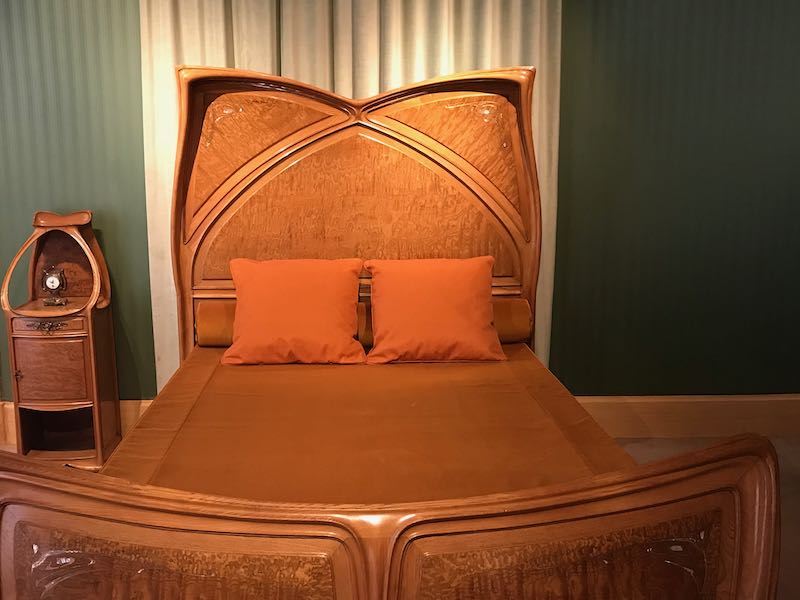
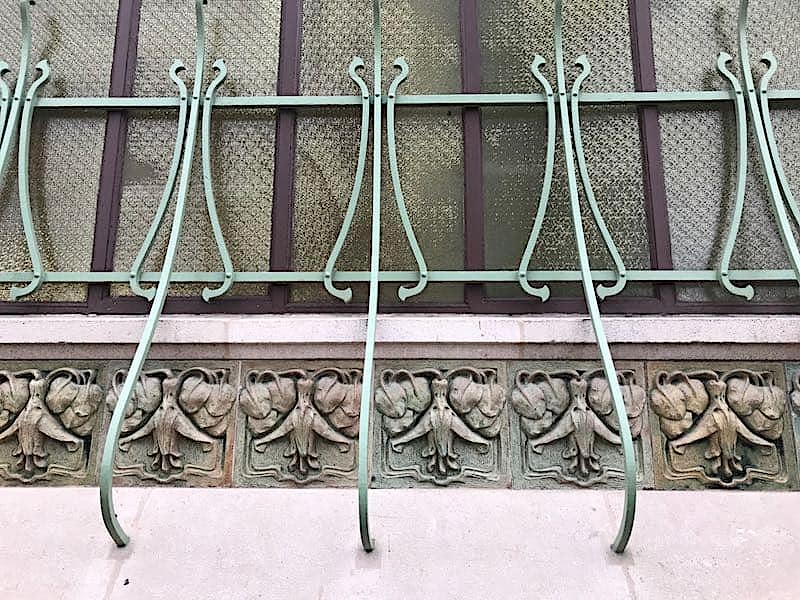 Various features of the Villa Majorelle in Nancy, France ©OffbeatFrance
Various features of the Villa Majorelle in Nancy, France ©OffbeatFranceAdded to Majorelle's genius was that of the architect, Henri Sauvage, and the sculptor Alexandre Charpentier. Together they fashioned this gem of a house and when it was built, in the early 1900s, it caused a furore. Waves and swirls everywhere!
Beware, though, only 60 people can visit at a time, so reservations are a must.
2. Musée de l'École de Nancy (Nancy School Museum)
The other iconic Ecole de Nancy venue is the museum of the same name. Also a former home (that of Eugène Corbin, whose funds subsidized the creation of the Nancy School), it is so perfect it will whisk you back more than a century with little effort.
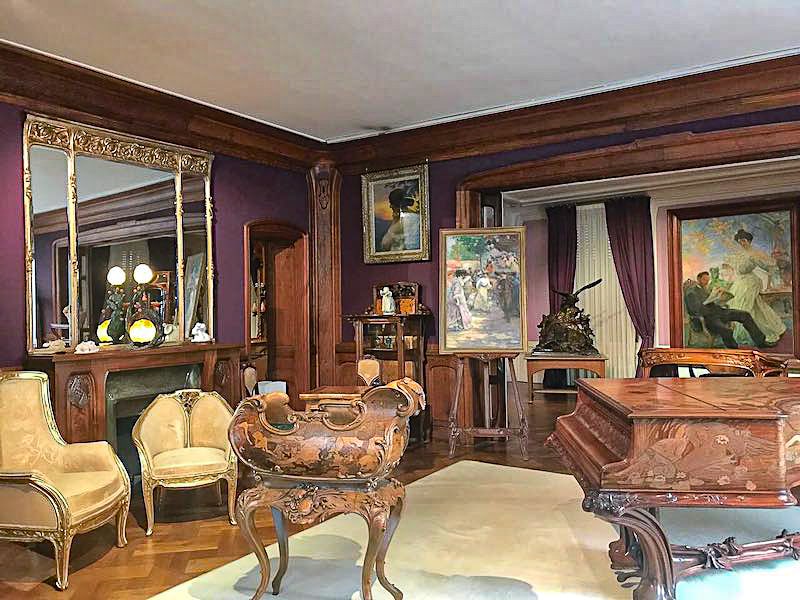 This one room captures it all: the piano (called Death of a Swan) by Majorelle, the planter by Emile Gallé and a cup by Prouvé and on and on. Just look around at all that detail ©OffbeatFrance
This one room captures it all: the piano (called Death of a Swan) by Majorelle, the planter by Emile Gallé and a cup by Prouvé and on and on. Just look around at all that detail ©OffbeatFranceOne of my favorite pieces in this extraordinary museum is known as "Dawn and Dusk", a magnificent bed designed by Gallé – his last design. The strong symbolism of life, a butterfly, can be seen on both the headboard and the foot of the bed.
Another remarkable piece is a tiled bathing nook, its author unknown. It is one of those structures that catches your eye and to which you keep returning, not knowing whether to love or hate it.
The house is full of beds, desks, lamps, armoires, chairs, everything required to live in comfort at the turn of the century, at a time of peace when one war was now behind France (the Franco-Prussian War) and another still ahead (World War I).
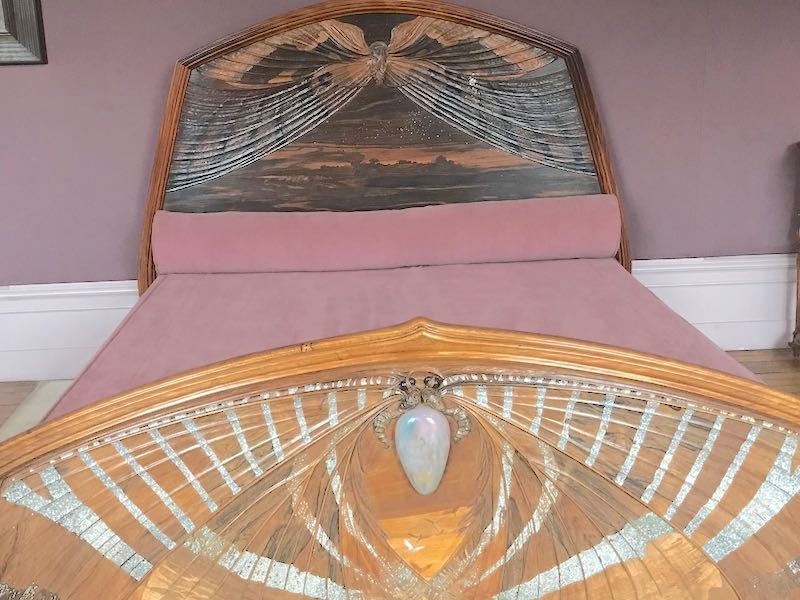 Emile Gallé bed
Emile Gallé bed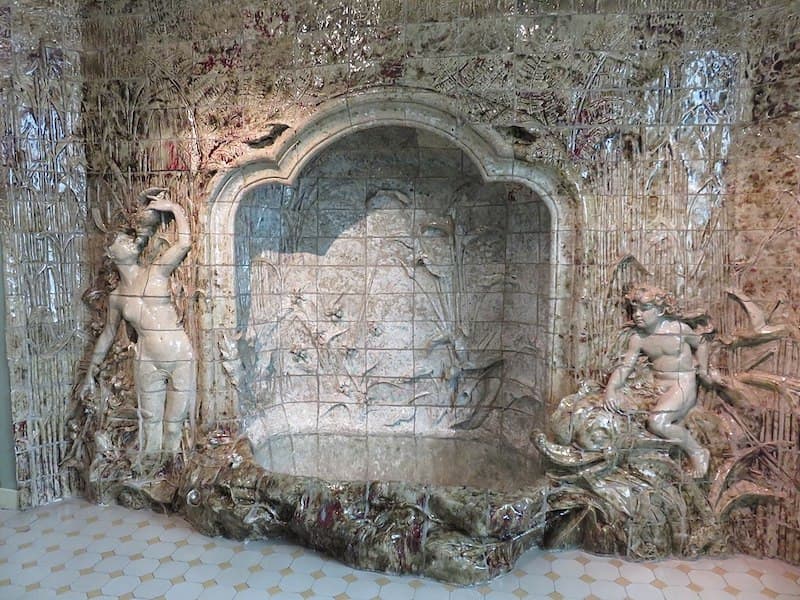 Bathing extravaganza
Bathing extravaganzaWHILE YOU'RE HERE...
Right near the museum is the wonderful Rue Félix Faure, where you'll find delightful, energetic houses designed by one of the leading architects of the period, César Pain. You'll find his work elsewhere in town, especially in Saurupt. He's in good company, with a few houses by Émile André as well.
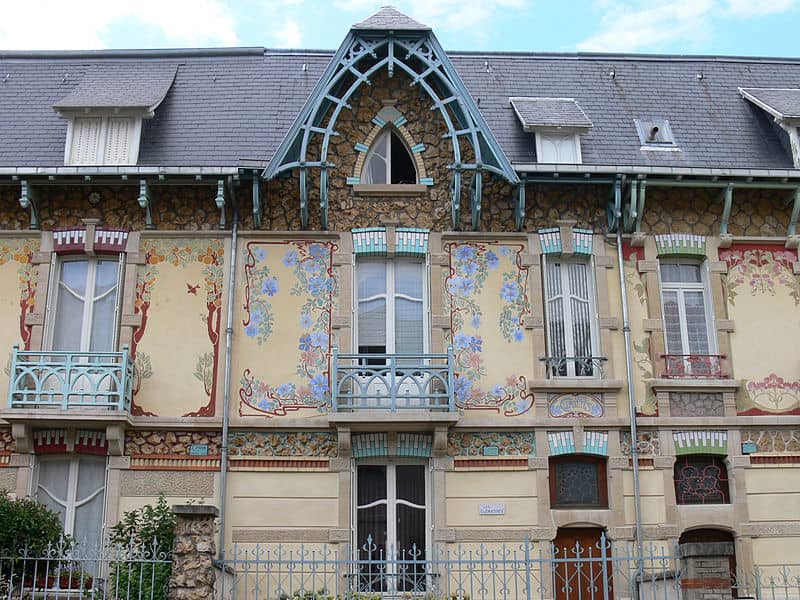 Houses by César Pain on the rue Félix Faure. Photo by François Bernardin, CC BY-SA 3.0, via Wikimedia Commons
Houses by César Pain on the rue Félix Faure. Photo by François Bernardin, CC BY-SA 3.0, via Wikimedia Commons3. Daum collection: Musée des Beaux-Arts
The Musée des Beaux-Arts is a fine museum, one of the oldest in France, and you can spend time wandering around its small but excellent collection − among which you'll find plenty of late 19th-century pieces.
For an immersion into Art Nouveau, head for the basement and the Daum crystal collection, unlike any other. As you walk through, you'll pass row upon row of priceless vases, urns, and glassware, all produced by the Nancy-based Daum family.
You'll find several distinct eras here, starting with the more classical glassware produced before the tidal wave of Art Nouveau swept all convention away, and then of course the Art Nouveau gems for which the Daum manufacture is so famous.
You'll also find a few Art Deco pieces and some that are even more modern, created in partnership with the likes of Salvador Dalí but, frankly, Art Nouveau glass is why you come here.
While you're in the basement, make sure you notice the stone ramparts: they may not be Art Nouveau, but they are all that's left of the ramparts which once circled Nancy.
The setting for all the glassware is perfect: high ceilings, encased in darkness, like nighttime filled with twinkling stars. Heaven.
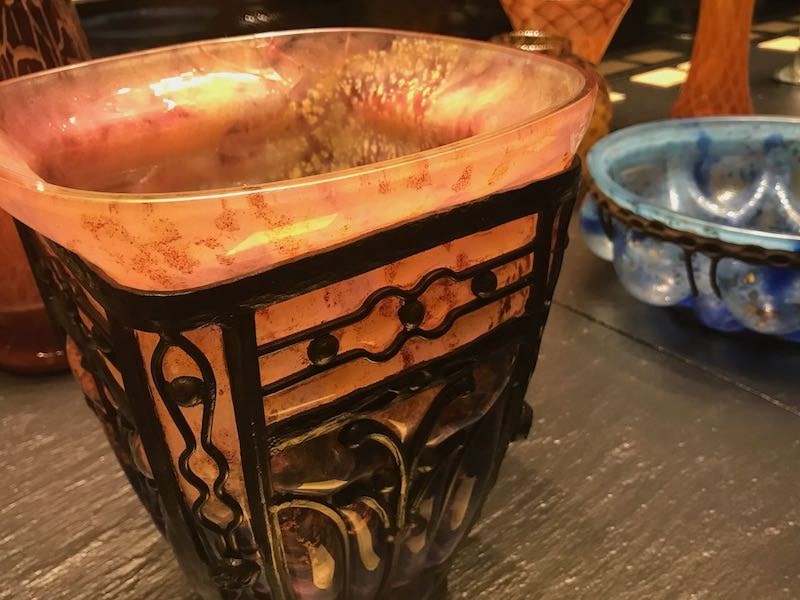
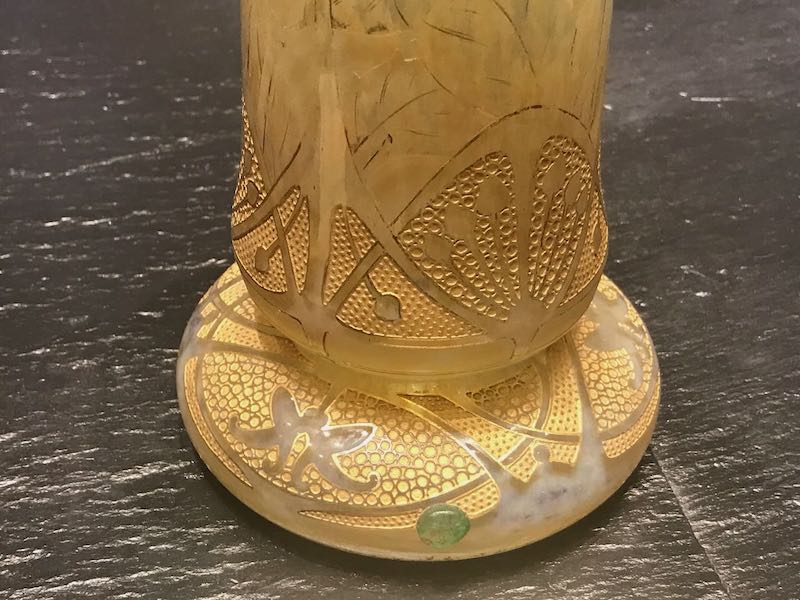
When you're done with the exhibition, head across Place Stanislas to the Daum shop, for a look at the latest exceptional creations.
Daum still manufactures glass wonders, but you can't visit the workshop − although you can visit its on-site store near the canal, where they sell the cast-offs. Don't worry, you'll never be able to see these pieces aren't perfect, and the only clue is the bargain price. (Check the tourist office for hours and location.)
4. The streets of Saurupt
Hop the tram and get off at Exelmans or Jean Jaurès – either one will do because the area you need to see is between the two.
This is a neighborhood that was built specifically to showcase the École de Nancy's architecture, and has its roots in that 19th-century influx of citizens fleeing German annexation. Nancy's housing market wasn't ready for all the new arrivals, who began crowding into the city center.
Since local authorities weren't doing enough to house everyone, private citizens decided to develop the Saurupt area to the south of the city. And so the Parc de Saurupt was born, a private development for well-heeled citizens. The developers called upon the best Art Nouveau artists and architects to build their little paradise, a gated community of 88 homes (you can still see the gate, designed by Louis Majorelle, on the Jules-Dorget square).
The housing market wasn't as great as expected so the grandiose vision had to be scaled back, and row houses, more affordable, were built. You can still see these today.
The entire Saurupt park was eventually completed in the 1930s, which is why, as you walk around the neighbourhood, you'll spot a few Art Deco buildings, the style that came after Art Nouveau.
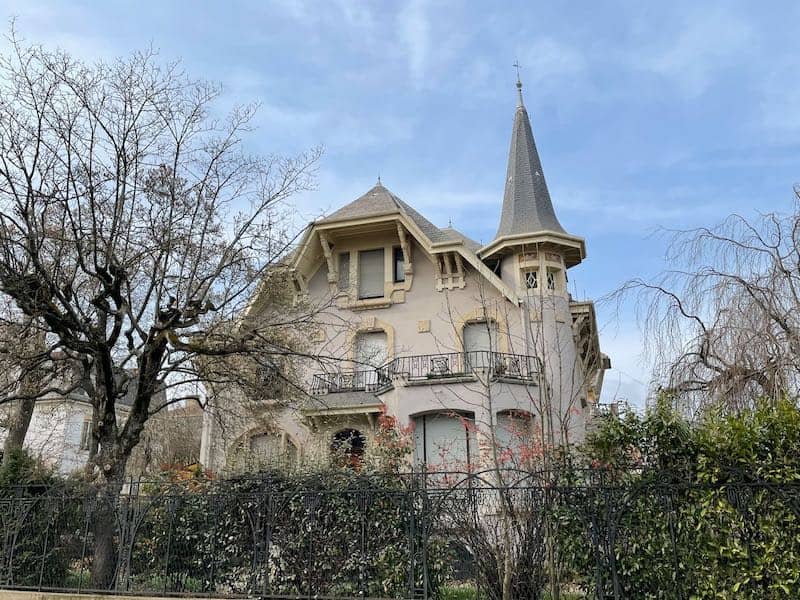
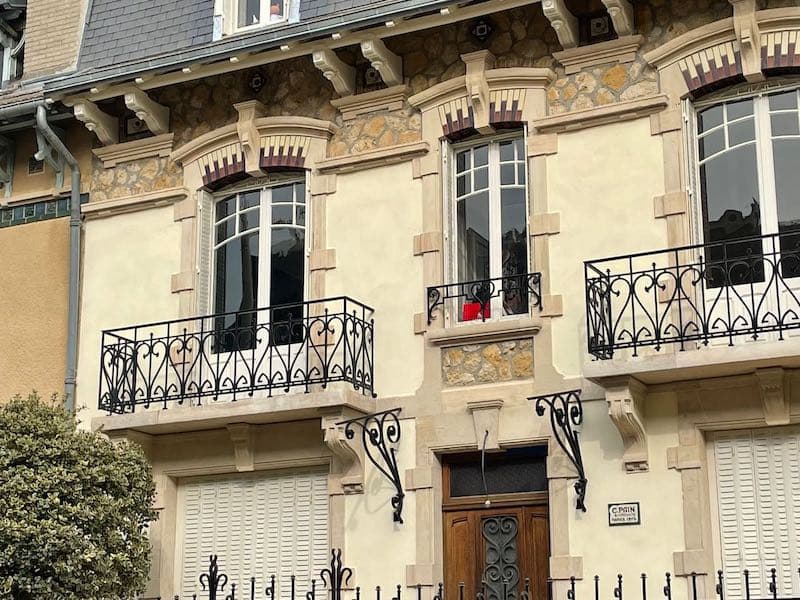
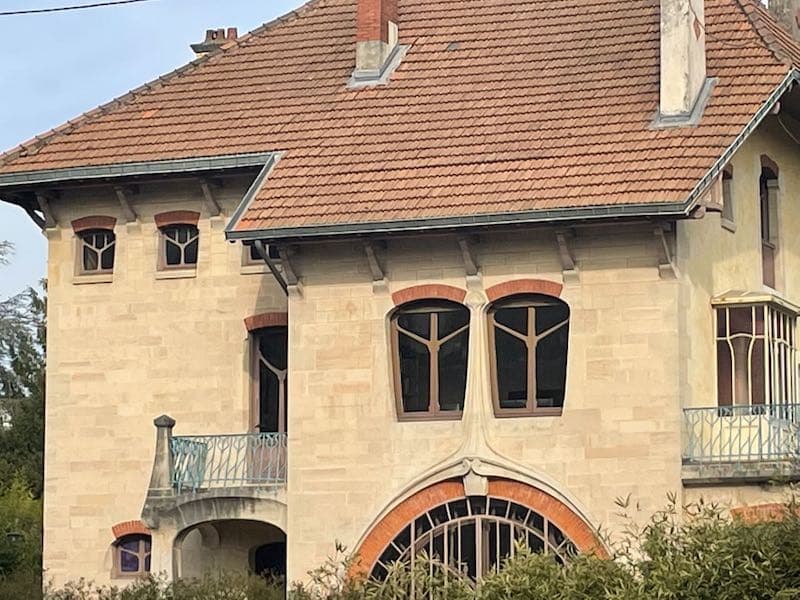
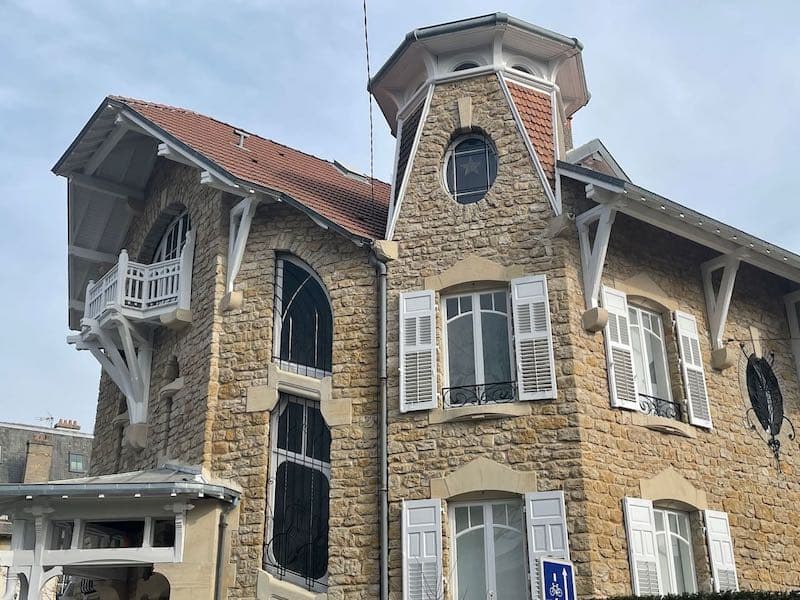 The four buildings above can all be found in Saurupt - there are many more
The four buildings above can all be found in Saurupt - there are many moreSomewhere in this area was the Maison Paul Luc, a large villa built by architects Henri Gutton and Joseph Hornecker and designed by such luminaries as Émile Gallé and Louis Majorelle. What a jewel that must have been!
Sadly, it was razed in 1968, a common trend at the time, but fortunately, many of its pieces – such as handrails, stained glass and furniture – were preserved by the École de Nancy museum.
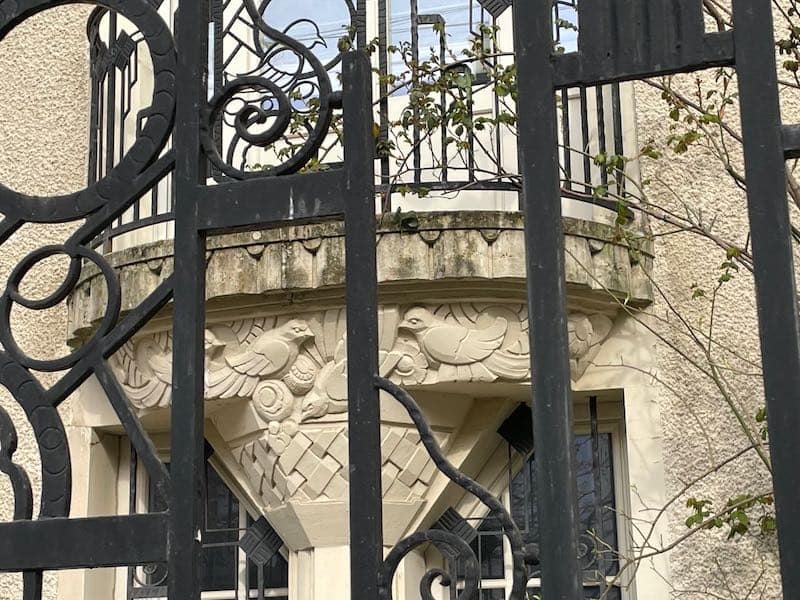
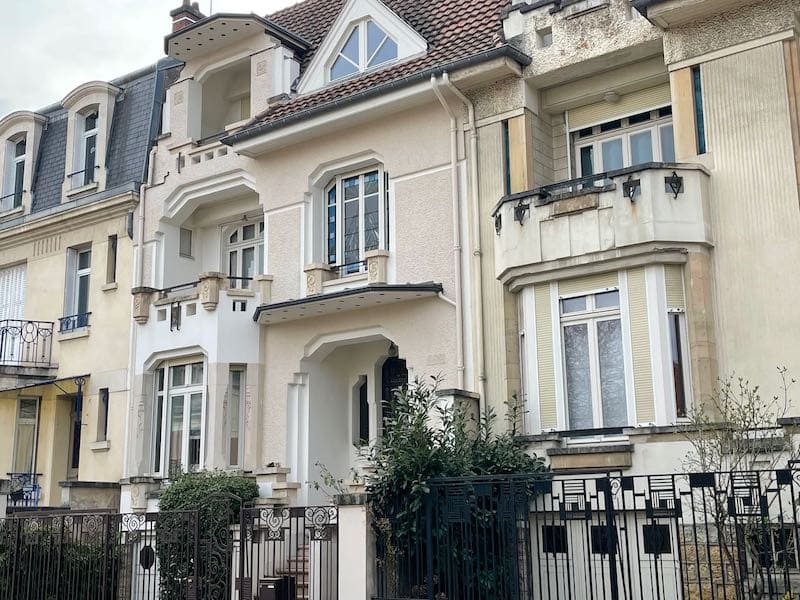 The two photos above are in Art Deco style, with the straighter, cleaner lines and a move away from the curviness of Art Nouveau. This isn't surprising since this part of town was built over both Art Nouveau and Deco periods
The two photos above are in Art Deco style, with the straighter, cleaner lines and a move away from the curviness of Art Nouveau. This isn't surprising since this part of town was built over both Art Nouveau and Deco periods5. Nancy's business district
Many parts of Nancy have a wealth of Art Nouveau buildings but one of the easiest to visit is the business district, a few blocks from the Place Stanislas. I used the itinerary below to guide my explorations.
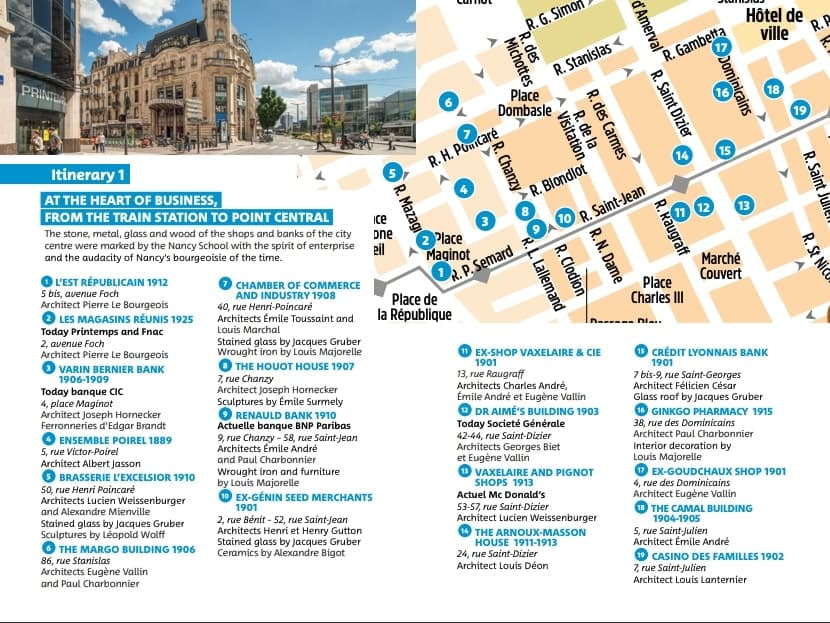 One of the Art Nouveau itineraries you can get from the Nancy Tourisme website (you can download it here)
One of the Art Nouveau itineraries you can get from the Nancy Tourisme website (you can download it here)Many of the buildings have been reclaimed by businesses, whether banks or corporations. All you have to do is look up or go in, and you'll see the striking Art Nouveau no one destroyed or covered over. I'm convinced Nancy is a city best seen with your nose up in the air!
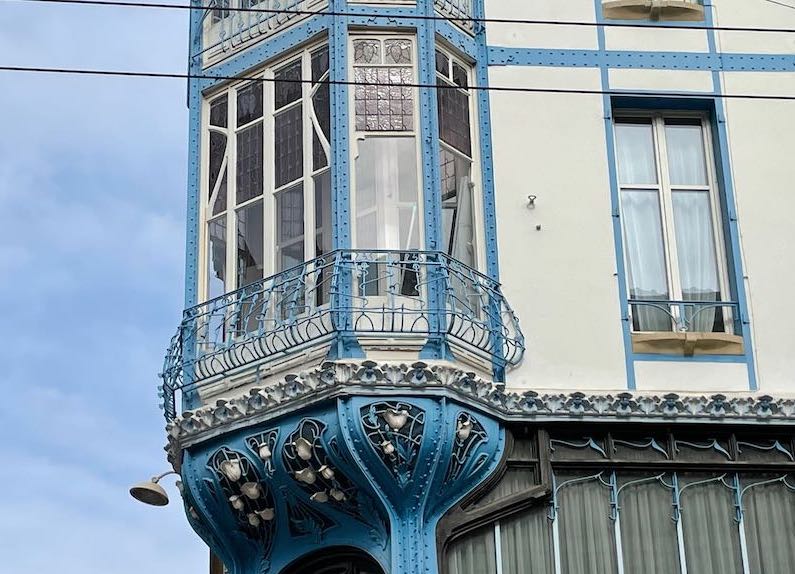
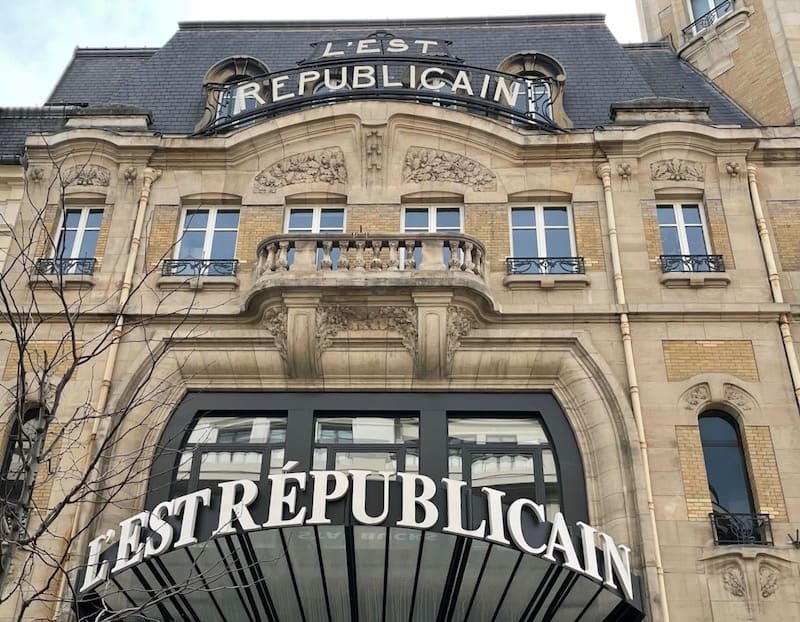 The top building now has a bank on the ground floor, and the Est Republicain has... Starbucks ©OffbeatFrance
The top building now has a bank on the ground floor, and the Est Republicain has... Starbucks ©OffbeatFranceWho were the most famous Art Nouveau artists from Nancy?
In France, their names resonate even today. Spot one of their works in a shop and you can expect a steep price tag.
Here are some of the big names, but you can also look at this much more detailed list of the École de Nancy artists. (The site is in French but the art is universal.)
- Émile Gallé: even if you don't know the name, you've seen this ceramicist and glassmaker's work − those sinewy glass paste lamps that look like svelte mushrooms in rich pastels?
- Louis Majorelle: he was an Ecole de Nancy furniture maker and woodwork artist whose house is now the Villa Majorelle.
- Eugène Vallin, a famous furniture-maker whose clients included such luminaries as Eugène Corbin (one of the first vice-presidents of the Ecole de Nancy)
- Auguste and Antonin Daum, the brothers whose glass creations remain famous to this day – and whose factory continues to produce.
- Eugène Corbin: he was the group's financier and cheerleader, and his former home now houses the Nancy School museum.
- Jacques Grüber: he worked in a variety of decorative arts but some of his most striking work can be seen in stained glass (look for it at the Nancy School museum, the Villa Majorelle, or when you have lunch at the Brasserie Excelsior).
- Émile André and César Pain, architects whose work you will spot throughout Nancy as they signed their work in stylized Art Nouveau lettering either at the entrance or on the buildings' façade.
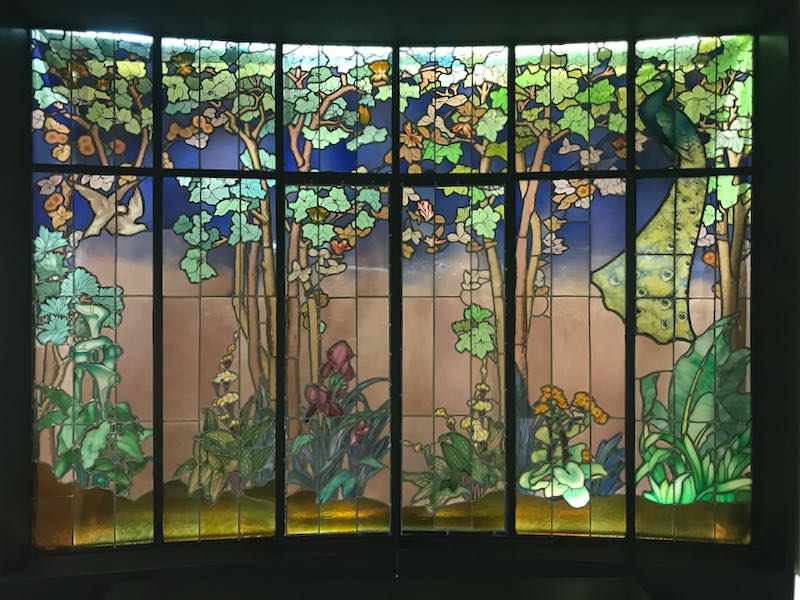 Stained glass window by Jacques Gruber, at the Musée de l'École de Nancy ©OffbeatFrance
Stained glass window by Jacques Gruber, at the Musée de l'École de Nancy ©OffbeatFranceA one-day Art Nouveau itinerary in Nancy
Nancy has such a wealth of Art Nouveau that fitting everything into a single day is a challenge. But you can see plenty in a day.
The Villa Majorelle (don't forget to reserve!) is only open in the afternoons, so you'll have to work around that schedule.
I suggest you start your day with the Daum Collection in the basement of the Musée des Beaux-Arts, followed by the Musée de l'École de Nancy, the Villa Majorelle, and a walk through Saurupt, the heart of Art Nouveau houses in Nancy. All these can be easily reached on foot or public transport.
You may not have time for a sit-down lunch if you only have one day, but this is your chance to sample a quick Quiche Lorraine from a bakery – it is, after all, a local specialty.
A two-day Art Nouveau itinerary in Nancy
If you have two days in Nancy, so much the better, because you'll be spoilt with Art Nouveau goodies.
You can also borrow (if you have the City Pass) an audio guide from the tourist office and use it to tour some of the Art Nouveau sights.
Distances are short in Nancy and public transport is excellent, so it won't take you long to get from one place to the next. The MyBus app (which you can download for free and use with your City Pass) will help you find your way.
Day 1 in Nancy
- 10:30 am: Start your visit with one of the daily tourist office Art Nouveau guided tours if you speak French (if you don't, use one of their multilingual audio guides).
- 12 noon: lunch at the Excelsior Brasserie (for the food, but also for its fabulous Art Nouveau décor). Make sure you reserve. Once there, observe the woodwork by Majorelle and the stained glass by Jacques Grüber.
- After lunch, head for the Avenue Foch to walk off your lunch and visit the Villa Majorelle (make sure you've reserved).
- Once you've finished with the villa, you can stroll through Saurupt or another of the Art Nouveau neighborhoods for which the Tourist Office has maps. It will depend on what you will have seen on your guided tour.
- 6 pm: Sit in a café on the Place Stanislas and wait for the blue hour. Then take yourself to dinner.
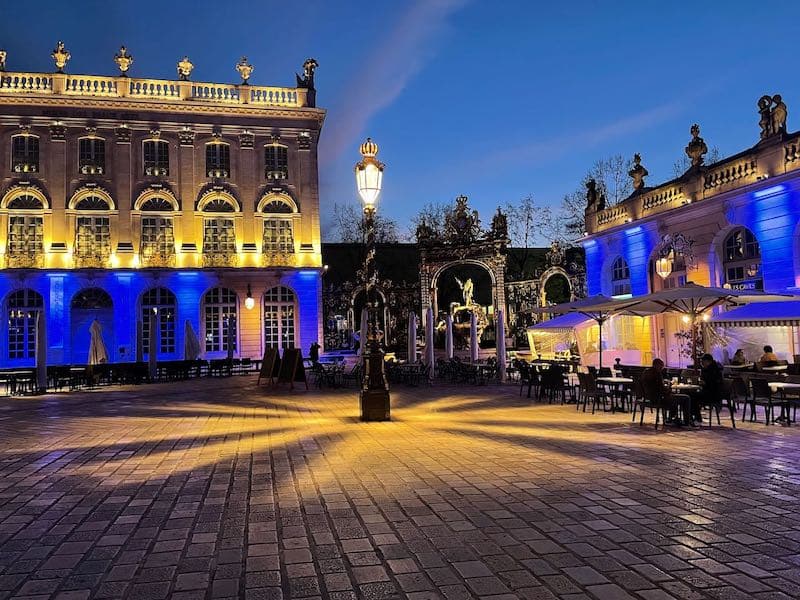
Day 2 in Nancy
- 10 am: Spend the morning browsing through the exquisite Daum glass collection in the Musée des Beaux-Arts. Supplement your visit by dropping in to the Daum shop just across from the museum, on Place Stanislas.
- 12 noon: Have lunch at the Café de la Paix, right across from the FNAC near the train station – delicious homemade food (and a chocolate mousse to die for).
- 2 pm (or whenever you finish lunch): Head for the Musée de l'École de Nancy.
- 4 pm: Take a walk around a neighborhood you haven't visited yet.
- 6 pm: Drop by the Soeurs Macarons and buy some to take home with you. They're a national treasure, and not like the Parisian macarons you're used to.
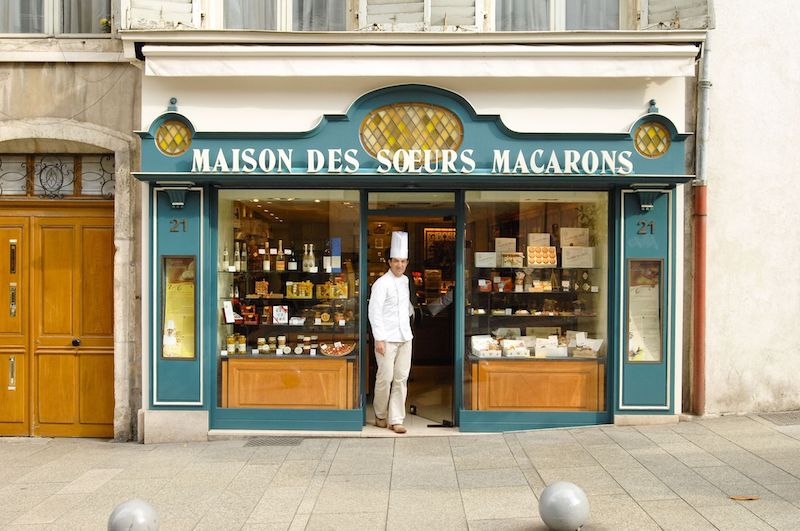 An obligatory stop in Nancy: Les Soeurs Macarons - and not just for looking, either! Buy a dozen, and prepare not to be able to put them down (Photo Nicolas Génot)
An obligatory stop in Nancy: Les Soeurs Macarons - and not just for looking, either! Buy a dozen, and prepare not to be able to put them down (Photo Nicolas Génot)While this is fully an Art Nouveau itinerary, there are many more things to see and do in Nancy!
Where to stay in Nancy
- A great budget option is the Victoria IV studio, halfway between the train station and Place Stanislas, a few minutes' walk from each. Modern and impeccably clean.
- More upmarket and right on the Place Stanislas, the Grand Hotel de la Reine is perfect for gazing across the square. Old world charm! And Marie-Antoinette stayed here...
- For something more artistic, with a few Art Nouveau (just a few) touches, you'll enjoy the Hotel des Prélats.
A few resources to visit Nancy
- Consider buying a Nancy City Pass. I used one during my stay and it was worth it: it covers all public transport in the city and entrance to all museums I mentioned above.
- If you'd rather be in control of your transport, why not see Nancy with an electric scooter? Traffic isn't dense in the city so you can get around without too much terror.
- And if you prefer the knowledge of a guide, try this Segway tour of Nancy and have someone point out all the best sights.
Did you enjoy this article? I'd love if you shared it!
You might also like these stories!
Pin these and save for later!
